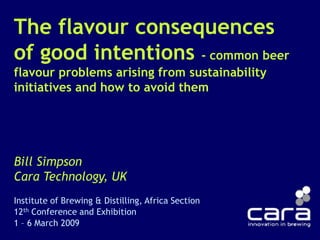The Flavour Consequences Of Good Intentions
- 1. The flavour consequences of good intentions - common beer flavour problems arising from sustainability initiatives and how to avoid themBill SimpsonCara Technology, UKInstitute of Brewing & Distilling, Africa Section12th Conference and Exhibition1 ŌĆō 6 March 2009
- 2. Sustainability initiatives in the brewing industry
- 3. Beer flavour and its control
- 8. ConclusionsŌĆ£Leave the environment where we operate as good as, or better than, we found itŌĆØReduceReuseRecycleŌĆ£One personŌĆÖs effluent is someone elseŌĆÖs ticket to richesŌĆØMinimize energy useMinimize wasteŌĆ£The future of brewing should be associated with zero waste, environmentally sustainable and clean technologiesŌĆØBuy locallyUse natural ingredientsMake productive use of wasteMinimize carbon emissions
- 9. ŌĆ£It is a science so obscure and imperfect that custom and preference, confirmed by ignorance, are its sole foundations, with sacrosanct dogmas no better than maxims blindly adopted without any examination of the principles on which they were founded.ŌĆØMarshal Saxe(1696 ŌĆō 1750) Reveries on the Art of War
- 10. Beer life cycleNew Belgium Brewing CompanyCarbon Footprint of Fat Tire® Ale3,188.8 g CO2 per six pack of beer
- 11. Contributions of different parts of the beer supply chain to carbon emissions
- 12. Beer flavour and its control
- 13. Target brand profile for a pale lager beer
- 14. Beer flavours which can be impacted by sustainability activitiesDiacetylSmokyCaprylicEarthyŌĆśYeast biteŌĆÖAcetaldehydeIsovalericŌĆśTrubbyŌĆÖWortyBromophenolLeatherySweetGrapefruitAstringentBurnt rubberButyricEthyl hexanoateWoodyMouldyAceticŌĆśCookedŌĆÖH2SFloralEthyl acetateEthyl butyrateMethionalIsoamyl acetatePhenolic (4-VG)GrainyRotten vegetableCaramelBitterMetallicCitrusMaltySolvent alcoholicMercaptanMustyIndoleHoneyChlorophenolDMS
- 15. How do we marry sustainability and flavour quality?
- 16. Risks to brand identity
- 17. Raw materials and brand flavour identityIs it really important to produce our beers with local raw materials?
- 18. What about the provenance of hops?
- 19. What strategies can we use to cope with shortages? ŌĆō How can we get the best out of a limited supply?Reduction in use of energy in the brewhouseand brand flavour identityBig reductions in energy used in wort boiling have been achieved through improved technologies
- 20. Evaporation rates have been reduced substantially
- 21. Flavour matching of the wort stream is not usually a key commissioning objective during upgrades ŌĆō it should beRisks of off-flavours
- 22. Local raw materials and their relationship to off-flavoursWater and water treatment
- 24. RiceMinimization of water use and its relationship to off-flavoursUnited Nations Environmental Programme (UNEP) says a typical water use figure for an efficient brewery is 5 hl / hl
- 25. FosterŌĆÖs Yatala brewery currently uses <2.3 hl / hl
- 26. Risks
- 27. Inefficient removal and killing of bugs
- 28. Product residues with flavour carry-overMinimization of extract loss and its relationship to off-flavoursLow last runnings gravities
- 29. Trub recovery
- 30. Fermentation extract loss and the risk of autolysis
- 31. Recovery of ethanol from spent yeastReduction in energy use and its relationship to off-flavoursNeed for early chill-back
- 32. Trade-off associated with use of off-peak energy
- 33. Cold maturation ŌĆō really a necessary ŌĆśevilŌĆÖ?
- 34. Pasteurization
- 35. Tunnel
- 37. Recycling of packaging materials and its relationship to taintsRisks associated with wood preservatives
- 39. Avoidance of problems associated with recycled paper and fibreboardConclusionsSustainability measures taken in all areas of the beer supply chain run the risk of impacting on beer flavour




















